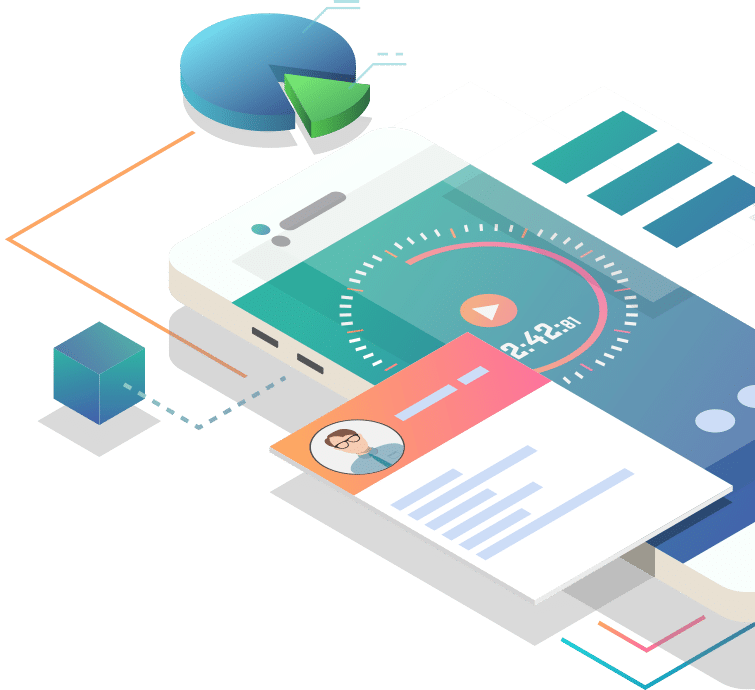
Turn Buyer Intent into Results
Volume One: The Basics of Intent Data
Only 3 percent of potential buyers are in the market at any given time, identifying and focusing on them is key to success. In VOLUME ONE, learn how:
- Intent data helps you get more leads and close more deals
- How to compare options
- Pick the right one and implement it.


The data is clear. If only 3 percent of the potential buyers for any given product or service are in the market at any given time (while 40 percent are poised to begin and 56 percent aren’t interested), identifying and focusing on those buyers, and those close behind them, is the key to efficiency and effectiveness in revenue growth. That’s been the Holy Grail of marketing and sales for years. After all, how many times have you heard a sales rep say, “If I’m sitting at the table, I win more than my fair share of deals. Just get me to the table!”
That’s the promise of intent data. And practice shows it’s more than just a theory. Fifty-percent increase in close rates and an 82 percent reduction in sell cycle have been attained. It’s a hot topic, and a lot of ink has been spilled on it. Yet black box solutions prevail, databases masquerade as intent data, theoretical predictive tools compete against actual activity observations, and most data only reports on account activity (missing the critical contact-level component). That simply doesn’t reflect the day-today realities of increasingly personalized sales and marketing. To top it off, most data today is sold based on partnership integrations — not the actual quality/value of the data.
So with all the hype, bluster, smoke and mirrors, and even well-intentioned misrepresentation, the challenge is to know whether intent data might offer you value, and if so, how to compare options, pick the right one and implement it.
Pro Tip: It sounds simple, but it’s often overlooked. Intent Data provides leads. Leads require active followup. You’ll need a machine to optimize the value!
That’s what this guide provides.
We dig into the world of real intent data and lots of other products with similar claims. We provide the tools you’ll need to compare and select, and we’ll explore use cases and tactics for implementation and execution. And of course, we’ll talk about privacy.
Behind all the technical jargon and differentiation, you’ve got one goal: Business growth. And that probably means qualified leads first and foremost. Any of these tools will provide leads.
Let’s dig in.
The Basics
Let’s start with some definitions. This is more complicated than it seems because there aren’t any commonly accepted definitions for what intent data really is. And it might surprise you to know that you’ve already been using it even if you haven’t subscribed. Generally, people talk about three types of intent data: first-, second-, and third-party intent data.
First-party intent data is the information you observe and collect in interactions with customers, prospects and visitors who interact with your website, email and social channels. Savvy marketers use this information to segment communications, score leads and create effective workflows. Salespeople use this data like “digital body language” to understand what’s happening in the deal and sales processes.
If you have an email program, email tracking, website trackers, marketing automation, social listening and similar tools, you’re already collecting, and hopefully using, first-party intent data.
There are also software vendors to help you extract more insight from your first-party intent data. Idio.ai and PathFactory, for instance, help to orchestrate engagement around your content and facilitate prospects’ buying journeys and purchase intent based on observations of their engagements on your site.

Second-party intent data is like first-party intent data, but it’s collected by another company. Common examples of this include review sites and publishing networks. Typically users register for access to information and grant the right (probably embedded in the Terms and Conditions of Use/community membership) for the owner to share/sell their contact details and information on their behavior. In some cases, this is done anonymously (just account-level information but no contact information) and in others, the sale of this information as leads includes individual contact details.
G2 Crowd and TechTarget are two well-known providers of second-party intent data. G2 Crowd has massive traffic and the appeal of peer-to-peer reviews (in addition to $100M in backing). Many tech companies rely on G2 Crowd’s information on account-level intent data to adapt their account-based marketing (ABM). TechTarget uses its expansive network of sites and content to observe actions and collect behavioral data indicating purchase intent. Many marketing and sales teams particularly value these leads which include information on the specific contact who’s looking and taking action.
Third-party intent data is like the Wild West. The premise is to observe actions taken everywhere on the internet—not just on a single site or network of sites. The challenges are daunting. How can one company observe and aggregate purchase intent and signals from the entire internet? Further, how can they associate those actions with any identifiable attribute?
- Reverse IP Lookup - As long as a company has a static IP address (not common among SMBs), then observations of “surges” or indicative activity from the address are interpreted as indications of account-level intent.
- Media Exchange / Publishing Members - In exchange for free, anonymous data, some publishing sites agree to provide “non-personally identifiable information from a publisher’s website visits.” That means account-level information. In some cases, cookies can be used within the network to identify actions which can be correlated to known users on your site. In other words, if they’ve converted on your property, and you’ve cookied them, their actions on sites that are part of the publishing network MAY be personally identifiable to you depending on the service you have.
- Using Data From Ad Networks and Widgets - Bidstream data (from ad exchanges) is one common source of intent data. Third-party intent data providers build on this because it can provide an enormous number of signals (as in billions per day). Customers who take a deep dive are often less enthusiastic when they discover the accuracy limitations of most of this purchase intent data and are further concerned when they learn that simply being served an ad (not actually clicking it) is interpreted as purchase intent.
The popular free website tools from AddThis and/or similar tools are another source. Websites accept use terms when they use the free tools that allow developers to collect and monetize all of the observed activity of the widgets and tools. If users of publishing networks, widgets and ads on sites and haven’t agreed to have their data shared, they might be unhappy to learn that it has been!
Well known third-party intent data sources include Bombora (typically sold through integrations with ABM tools or through Everstring and its partners) and TrueInfluence.
Pro Tip: Privacy is an understandable concern when it comes to Intent Data. Lattice Engines CEO Shashi Upadhyay provides a powerful primer in his LinkedIn article here (and you can view our Privacy Policy here.)
There is another third-party intent data methodology that uses multi-variable linear regression analysis to correlate observed actions with a specific contact. This is the method that the LeadSift engine of IntentData.io data uses. This is distinct in several ways:
- IntentData.io intent data is built on all publicly available information that’s independently observed and collected. Therefore there can be no potential violation of Terms of Use of data from various sources which might create an exposure.
- It provides the actual info of the individual taking the action when the action is individual in nature. IntentData.io also can provide company-level behavior data and purchase intent, such as recently funded and new office, which are inherently account-level in nature. In those cases we suggest a likely decision-maker for outreach.
- It observes the activity across the entire public internet, not a limited network of sites, or those with specific installed tools.
Pro Tip: Understanding the nuance here is important to make the right choice. Are your typical buyers using static IP or not? Is the size of your targets small enough and typical buyer so easily identified that you can easily reach the right person? And is there only one buyer involved in choosing your product?
Account Data Versus Contact Data
Do you sell to accounts or to people? If your CRM stops at the company/account level, then most third-party intent data will work fine for you. However, if you actually engage with individuals—people with priorities, problems, aspirations and objectives—and use accounts as a tracking tool, then third-party intent data which cannot report on the actual engaged contact will often disappoint.
In other words, if you sell to IT leaders at enterprise companies and you know only that “some person” at CitiBank has engaged with “cybersecurity,” then you’re faced with an undesirable choice: Blasting the entire IT team with information that will likely be irrelevant to them (at great cost) or calling the switchboard to ask who in the IT department was searching. Not much of a choice. Is there value in knowing that an unidentifiable person/people at an account are taking action? Of course. And if your typical account only has 10 employees, then that may be all you need. But in an era of increasingly personalized marketing and sales, it’s simply inadequate to not know who the people are.
Now, you might say, “But lots of third-party data providers include contact details.” That’s correct. But the devil is always in the details. Remember that the background data is built on “non-personally identifiable” information. It’s that simple.
In an implied acknowledgment of the fact that that’s simply not enough, various data providers will “append” or “overlay” contact details on the intent signals. In other words, knowing that you really want to speak to a particular title/role/function/seniority, they’ll search unrelated data sources to find the contact details of people who match your ideal buyer and send those to you as though that’s the person who took the action.
They typically can’t and don’t know who actually took the action, but they report the data as though they know precisely who it was and many buyers may not be getting what they were led to believe they would.
But not every company needs to know who the individuals are. If you have a list of the key players at each target account, then you may be comfortable simply knowing the account is active enough to let you toggle on LinkedIn ads, personalized direct mail and other approaches.
Select the option that provides the info you need and make an informed choice.
The Data Sources
What range of sources do you want or need? And what strength of signal do you consider indicative of actual intent?
Behind fanciful names and grand assertions, the source of most third-party intent data is a real “black box.” That means that users interpret and react without really understanding the context. They’re told, “This person has intent to buy what you sell.”
Make sure you’re clear where the data is sourced so you can gauge the accuracy and relevance and incorporate it correctly into your marketing and sales process.Granularity & Volume of Data
Better is Better . . . Not More
Volume of data is not a proxy for quality or value, although it’s often sold that way. How many BDRs would you need to manage 1,000 intent data leads/day? Or to thoughtfully incorporate the data into your accountbased marketing (ABM), conversational marketing and other strategies?
After unrelated contact details, the most common concern cited by users of intent data is the process of activation—or turning the leads into conversations, pipeline opportunities and revenue. Absent critical details of context, that’s a process of brute force and expensive ads.
For instance, it’s common that third-party intent data is sourced based on “topics.” That’s convenient up front—you can rely on someone else to decide what fits into that topic and you don’t have to spend the time doing the detailed work to configure the algorithm according to your specific needs.
What’s in the Data?
But what are the components of a “topic”? What’s the taxonomy? If you select “Demand Generation” as a topic, does that include engagements with content on PPC? Marketing automation? Intent Data? TechTarget? Predictable Revenue?
Of course, you don’t know. The price of the upfront convenience is opacity and lack of information. The alternative is intent data that’s reported with the contextual details included for each lead. For instance, if you’re trying to understand who’s in the process of researching CRM, capturing every social interaction with SalesForce.com could provide a great lead volume or largely irrelevant data. If everything is aggregatedunder a topic, you’d never know.
In contrast, if you knew that someone took action with online content around specific terms like “pipeline management” and “best CRM” and “client tracking for HVAC contractors” you’d understand a bit about where they are in their buying journey. If you knew that they followed John Barrows or Bob Apollo, you’d understand something about the kind of sales force they have. And if you knew which specialized service a current customer was researching, your success team would know exactly how to approach the upsell opportunity to delight them and prevent churn.
Unlocking the Value of Data
It’s that rich insight and context that represents the real value. The fact that some anonymous user took action behind an IP address doesn’t help sell. Even the fact that a qualified buyer with the right title downloaded a whitepaper on a certain category of software doesn’t necessarily provide all the context you’d like.
But seeing multiple people (as frequently happens when you know who the contacts are individually) from the same company engaging with related but different specific terms can help the marketing team to determine the problem they’re trying to solve, the types of solutions they’re considering, the competitors on the shortlist, and the various people on the buying team.
Enabling Activation
That’s where data is translated into revenue. That’s the connection that normally impedes activation. On the one hand, companies simply show ads to anyone they can identify with an appropriate title and hope someone bites. On the other, they can build ABM workflows and sales templates and scripts which speak specifically to the issue prospects/customers have.

Pro Tip: Understanding the nuance here is important to make the right choice. Are your typical buyers using static IP or not? Is the size of your targets small enough and typical buyer so easily identified that you can easily reach the right person? And is there only one buyer involved in choosing your product?
Parsing the signals The anatomy of detailed, contextual, contact-level data

The two key discriminators in third-party intent data are the important account (anonymous user) versus contact-level identification, and the source of the data. We’ve discussed those at length, but let’s dive into what they mean in terms of actionable data that is fed into your CRM and marketing automation.
Granular, contextual intent data should provide the following:
- First & last name
- Work email & phone
- Title
- Company name & website
- City/state/country
- Industry
- Company size
- Twitter handle & LinkedIn profile.
It should also provide the following signals:
- Competitor engagement
- Key term engagement (in other words, took action on
an article optimized around one of your key terms) - Company recently funded
- Key role changes (e.g. CFO)
- Industry conference/Trade show engagement
- Influencer engagement
- New product
- Hiring
- Key contacts
- Social follows (prospect followed company & company followed prospect)
Signals should be refined with granularity to provide the context important to personalizing marketing and sales. For instance:
- Identifying the competitor, event or influencer with which engagement occurred
- Identifying the key term with which engagement occurred (and thereby problem to be solved, stage in buying journey, etc.
- Specify the roles for which hiring is a leading indicator
Type of services
While second-party data (like TechTarget) and typical third-party data (like Bombora) are probably the bestknown intent data varieties, the buzz and lack of clear definitions in the space means that there are lots of adjacent solutions which are often conflated with real intent data. Further, some of these services overlap, and some vendors (and their customers) might feel strongly that they’re miscategorized here.
Pro Tip: There are lots of overlapping services and solutions targeted at certain size companies at different stages in maturity. Define your goals first, then look for products that fit. Don’t buy buzz.
These other product categories include:
Static Databases - These are valuable tools for marketing and sales, and teams have relied on them for years. Common examples include DiscoverOrg, ZoomInfo, LeadIQ and LinkedIn Sales Navigator. Quality and range of data vary by source. The gold standard has been periodic telephone verification. Today that’s combined with technology-enabled mining and verification as well. Generally, these tools compliment rich intent data and you will likely use both. Recently, some databases have begun to incorporate some account-level third-party intent data as they recognize the market expectations are evolving from static to contextual information.
Website De-anonymizers - A great website may convert 5 percent of visitors. That means 95 percent are visiting anonymously. This set of tools aims to help identify those visitors who you’ve cookied but haven’t converted. These tools include Lead Forensics, Leadspace, Voogy and Visual Visitor.
When comparing these tools to other intent data sources, the questions to ask relate to range and reach. You could well argue that visitors to your site are the most engaged potential prospects, and maximizing that latent resource is the highest priority. That’s a valid argument. Extended, however, it also applies to those researching elsewhere and interacting with competitors. Should you walk away from those prospects?
If only 3 percent of the market are active buyers, not everyone buying searches all terms, and great non-branded organic search terms ranking 1-3 have a CTR of 25 percent, then you’re probably only seeing half to 1 percent of the total potential market on your site—if you’ve done a really great job at identifying all the key terms and creating compelling content to rank, get clicked and engage. Additionally, this omits the critical information regarding competitor interactions that’s important for marketing personalization, sales effectiveness and churn reduction.
Predictive Tools - There’s a lot of growth and activity in this space. Some of it is fascinating science, and some is more like traditional data with a .ai domain and claims of amazing data mining. Typically tools insert first-party intent data (from your own properties) with second- or third-party signals. 6Sense, for instance, has built upon Bombora account-level third-party data and a second-party anonymous activity on the Forbes publishing platform.
Data Enrichment - Tools like Clearbit offer rich contextual information on website visitors, in addition to their own prospecting tools. Through reverse IP lookup, they also provide de-anonymization. This kind of information is helpful if, for instance, your ideal prospect uses a specific type of software or is in a specific industry. Real-time information can be used to enable tailored experiences (e.g. chatbots) accordingly.
Sophisticated lead scoring is often part of this model as well. For accounts with large historical databases, predictive tools will often mine leads, win and lose data to identify attributes of prospects/customers that correlate to success. That can be used to prioritize inbound leads, filter intent data and focus on likely target accounts.
Enterprise ABM Platforms - One of the most compelling use cases for intent data is in ABM. Executing ABM at scale is difficult and complex. Some platforms provide integrated enterprise ABM coordination, and they often they incorporate third-party intent data as an element of their service. In some cases, clients can purchase some form of blended predictive/third-party intent data, but the real focus of these platforms is on their powerful, integrated, enterprise-size ABM platform.
With the right data, and some reasonable marketing automation, even small companies and their middle market siblings can create effective ABM engines themselves.
Orchestrated Intent Data - Selecting the right intent data solution for your business will depend as much on how you’ll handle the data as the data type, vendor, granularity and context that you select. Data without effective activation is of zero value, and activation is hard. It’s technically complex and requires creativity, agility and rigorous execution. Some companies can manage it. Others think they can and discover they’re falling short. And some recognize they’re better off bolting on a program. Some companies use a variety of third-party intent data sources and they work to integrate intent data into the demand gen process.
Get What You Expect And What You Need
You have lots of options. If you sell a product with a global universe of only 50 customers and you’ve got pods of product marketers and sales who are consistently cultivating dialog with the key 50 people at each account, then you might only need a good, accurate, verified database.
Maybe you’re a manufacturer at capacity and can’t scale fast enough to worry about grabbing market share, but want to grab the low hanging fruit of your current website visitors. You might just need de-anonymization.
Or maybe you’ve got so many unmined leads in your database from years of marketing and poor follow-up, that you simply need predictive tools to know which ones your reps should focus on.
Third-party intent data isn’t the only answer, and it’s not the best answer for every company and situation. Armed with an understanding of the landscape, however, you can make an informed decision based on your business situation and priorities.
Now that you know the basics of intent data, it's time to discover use cases and the application of purchase intent to generate leads and drive sales.
Fill out the form below to read Volume 2: Using and Applying Intent Data
